Returns On Capital At Shanghai HIUV New MaterialsLtd (SHSE:688680) Have Stalled
If you're not sure where to start when looking for the next multi-bagger, there are a few key trends you should keep an eye out for. One common approach is to try and find a company with returns on capital employed (ROCE) that are increasing, in conjunction with a growing amount of capital employed. Put simply, these types of businesses are compounding machines, meaning they are continually reinvesting their earnings at ever-higher rates of return. However, after briefly looking over the numbers, we don't think Shanghai HIUV New MaterialsLtd (SHSE:688680) has the makings of a multi-bagger going forward, but let's have a look at why that may be.
Return On Capital Employed (ROCE): What Is It?
If you haven't worked with ROCE before, it measures the 'return' (pre-tax profit) a company generates from capital employed in its business. Analysts use this formula to calculate it for Shanghai HIUV New MaterialsLtd:
Return on Capital Employed = Earnings Before Interest and Tax (EBIT) ÷ (Total Assets - Current Liabilities)
0.10 = CN¥317m ÷ (CN¥6.5b - CN¥3.3b) (Based on the trailing twelve months to December 2023).
Therefore, Shanghai HIUV New MaterialsLtd has an ROCE of 10.0%. In absolute terms, that's a low return, but it's much better than the Chemicals industry average of 6.1%.
View our latest analysis for Shanghai HIUV New MaterialsLtd

Above you can see how the current ROCE for Shanghai HIUV New MaterialsLtd compares to its prior returns on capital, but there's only so much you can tell from the past. If you'd like to see what analysts are forecasting going forward, you should check out our free analyst report for Shanghai HIUV New MaterialsLtd .
The Trend Of ROCE
There are better returns on capital out there than what we're seeing at Shanghai HIUV New MaterialsLtd. The company has consistently earned 10.0% for the last five years, and the capital employed within the business has risen 582% in that time. This poor ROCE doesn't inspire confidence right now, and with the increase in capital employed, it's evident that the business isn't deploying the funds into high return investments.
On another note, while the change in ROCE trend might not scream for attention, it's interesting that the current liabilities have actually gone up over the last five years. This is intriguing because if current liabilities hadn't increased to 51% of total assets, this reported ROCE would probably be less than10.0% because total capital employed would be higher.The 10.0% ROCE could be even lower if current liabilities weren't 51% of total assets, because the the formula would show a larger base of total capital employed. So with current liabilities at such high levels, this effectively means the likes of suppliers or short-term creditors are funding a meaningful part of the business, which in some instances can bring some risks.
The Bottom Line
Long story short, while Shanghai HIUV New MaterialsLtd has been reinvesting its capital, the returns that it's generating haven't increased. Since the stock has declined 61% over the last three years, investors may not be too optimistic on this trend improving either. Therefore based on the analysis done in this article, we don't think Shanghai HIUV New MaterialsLtd has the makings of a multi-bagger.
Like most companies, Shanghai HIUV New MaterialsLtd does come with some risks, and we've found 2 warning signs that you should be aware of.
For those who like to invest in solid companies, check out this free list of companies with solid balance sheets and high returns on equity.
New: Manage All Your Stock Portfolios in One Place
We've created the ultimate portfolio companion for stock investors, and it's free.
• Connect an unlimited number of Portfolios and see your total in one currency
• Be alerted to new Warning Signs or Risks via email or mobile
• Track the Fair Value of your stocks
Have feedback on this article? Concerned about the content? Get in touch with us directly. Alternatively, email editorial-team (at) simplywallst.com.
This article by Simply Wall St is general in nature. We provide commentary based on historical data and analyst forecasts only using an unbiased methodology and our articles are not intended to be financial advice. It does not constitute a recommendation to buy or sell any stock, and does not take account of your objectives, or your financial situation. We aim to bring you long-term focused analysis driven by fundamental data. Note that our analysis may not factor in the latest price-sensitive company announcements or qualitative material. Simply Wall St has no position in any stocks mentioned.
About SHSE:688680
Shanghai HIUV New MaterialsLtd
Engages in the research and development, manufacture, and sale of polymer films in China.
High growth potential with adequate balance sheet.
Market Insights
Community Narratives




